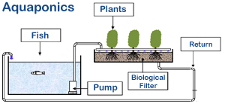Lighting for Aquaponics
Aquaponics is the integration of hydroponics – growing plants without soil – and aquaculture – fish farming. It’s a symbiotic ecosystem that uses the waste produced by fishes as nutrients for growing plants. The fish waste is broken down by nitrifying bacteria initially into nitrites and subsequently into nitrates, which are absorbed by plants as nutrients. The clean water is then recirculated back to the fish tank and the cycle repeats (figure below).

Aquaponics provides for an efficient way of growing leafy greens and vegetables in an eco-friendly manner. For example, Aquaponics uses 90% less water than traditional farming, while simultaneously producing on average six times more yield per square foot. Operators of aquaponics facilities typically sell both the plants and the fish. Fish species commonly farmed include tilapia, salmon, bass, carp, brim, and koi. According to Zion Market Research, the global aquaponics market was valued at approximately $0.5 billion in 2017 and is projected to increase to $1.3 billion by 2024, representing a compound annual growth rate of 10%. Some of the key companies participating in aquaponics market include The Aquaponic Source, Aquaponic Lynx, Greenlife Aquaponics, Aqua Allotments, Backyard Aquaponics, UrbanFarmers, ECF Farmsystems, Nelson and Pade, My Aquaponics, and Ultrasonics Canada Corporation.
For plants to remain viable at an aquaponics farm, photosynthesis is required, which means there must be a source of light. Light can be natural (sun) or electric, or a combination of both. Frequently, aquaponics operations are located in greenhouses where natural sunlight is abundant. But during winter months electric light is used to supplement the sun to ensure plants continue growing at an ideal pace. There are several considerations when choosing supplemental lighting including the optimal lighting technology, spectrum, installation, reliability, and cost. LED technology has become a popular choice recently due to increasing energy efficiency and lower up-front cost. Other lighting technologies are fluorescent, metal halide and high-pressure sodium (HPS). While the initial cost of these other technologies is lower than LEDs, operating costs are substantially higher due to lower energy efficiency. In addition, fluorescent, metal halide and HPS have much higher heat content transmitted to the plant, which can cause yellowing or burning of the plant if the light source is too close.

Thrive Agritech recently supplied LED lights for aquaponics to BellaVita Farm in Brookeville, Maryland. The farm produces a wide variety of leafy greens, tomatoes, and microgreens for sale to nearby high-end restaurants.